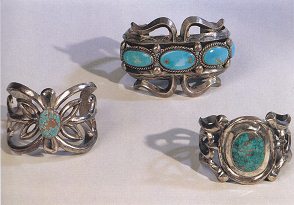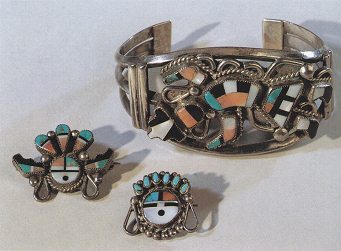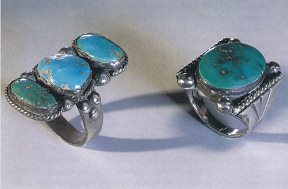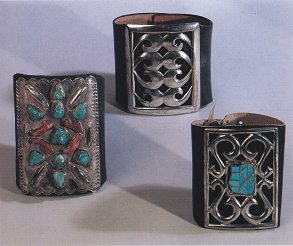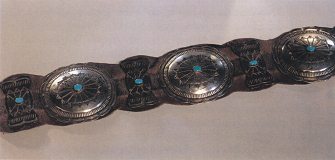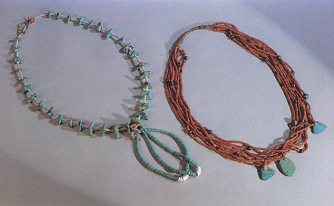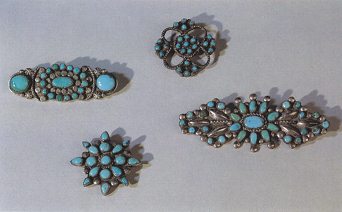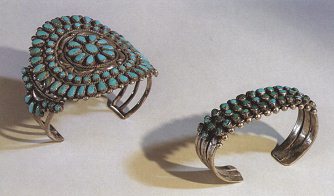|
|
|
North "American" Primary Nations Museum (North America Native Museum) Zurich
8. Jewelry - silver jewelry of Navajo and Zuñi primary nations
Armlets with turquoise gemstones of Navajo primary nation (photo 4)
Jewelry of Zuñi primary nation in mosaic style (photo 7)
presented and translated by Michael Palomino (2012)
Share:
|
|
|
from:
Prestel museum guide, text by Denise Daenzer and Tina Wodiunig: Native Museum of Zurich (orig. German: Indianermuseum Zürich / Indianermuseum der Stadt Zürich); Prestel edition; Munich, New York 1996; supported by Cassinelli Vogel foundation, Zurich, by MIGROS percent for culture, by Volkart foundation in Winterthur; ISBN 3-7913-1635-4
<Jewelry
[Jewelry from the times before white imperialist invasion: made of stones, of bones, of wood, of teeth, of horn, and of seashells]
There were two kinds of handicraft which were transformed basically by the cultural exchange with the whites, these were painting and jewelry, above all silver jewelry. Before the contact with the whites metal work was mostly unknown in North America - with the exception of simple procedures winning and working with copper. Jewelry mainly was made of stones, of bones, wood, teeth and seashells (photo 8). Seashells also were spread and used for handicraft work also in widely other regions thanks to commercial links.
[The white imperialist teaching the work as silversmith to the natives]
Only in the beginning of 19th century the white man was teaching the natives of Eastern North America the art to be a silversmith. Since then this silver handicraft has spread over all Northern America, with a hot spot in South West where the mostly loved native jewelry comes from. Here the Navajo member Atsidi Sani was the first one learning this difficult handicraft work between 1853 and 1868, learning it from a Mexican silversmith. Later Atsidi Sani also learnt his sons and other members of his tribe the new handicraft. It's assumed that this art has been a familiar heritage then given from generation to generation. After 1870 this silversmith handicraft was given from Navajo to Zuñi primary nation, and those gave it to the Hopi - presumably between 1890 and 1895. But the pioneer role came from the Navajo, and because of this we will speak as a focus about their development of silversmith art.
First silver jewelry in South West was produced by hammering. The first raw material were American silver coins until it was forbidden by law in 1890. Then Mexican coins were used. Tools of the native silversmiths were chisels, files, awls and hammers purchased from the Spaniards. In about 1875 the first peaces were produced in forms of pumice or sandstone. Producing the forms ornamental designs and a channel for the fluent silver were carved into the stone. Then a false stone was put on the form, and all was well bundled. Then silver was melt and given into the channel filling the form with the design. After cooling the stones were opened and the metal form was taken out and was dragged and polished giving it's definite shape.
[Silver jewelry with turquoise art gemstones of Navajo primary nation since 1880]
Shaping silver finger rings the Navajo were working in 1880 the first time with turquoise gemstones. Since then these turquoise gemstones got very popular above all for armlets. Navajo silversmiths preferred single big (p.55) gemstones using them only in an economical way. Their specialty were relatively simple forms, but perfection in shaping and polishing the silver surface.
[The jewelry of "shells" of the Navajo]
Most known Navajo silver works are the "shells" (Spanish "concha"), an originally round, later also oval silver plate fixed on a leather belt (photo 2). Until today there is no scientific harmony about the origin of this "shell", whether the origin is coming from stickers of "German Silver" (an alloy of copper, zinc, and nickel). This German Silver sticker was worn in the Plains as a hair ornament or on belts. Or another possibility of origin would be the Mexican culture having this shells as ornaments at their bridle of their horses. Early "shells" ("conchas") has only two holes in their center (p.56), and a leather strap could be passed through it. Later there was often soldered a metal ring at the underside winning more space on the "concha" for more ornaments. At about 1900 also turquoise gemstones were used for ornaments of shells. The belts had also other ornaments like little ornamented silver peaces between the "conchas". These little silver peaces were called "butterflies" because of their form (see photo 2).
[Wrist protectors "ketoh"]
There were jewelry peaces which never were produced in a wide range but were only for the own personal use or for native neighbor groups. Wrist protectors "kethohs" were of those only produced in a little edition (photo 5). These rectangular plates curved in form of a wrist were produced in copper first, later in silver. They served the archers as a wrist protection and were mostly worn during ceremonial festivities. The hammered peaces have an engraved design and sometimes also are ornamented with some turquoise gemstones. The poured "ketoh" mostly is in form of an S or is ornamented with the design of a stylized corn plant. for commercial purpose "ketoh" nowadays is also produced in form of belt buckle (p.57).
[Necklaces of Navajo primary nation]
[Necklaces of Navajo: pumpkin flowers]
These Navajo necklaces have got some characteristic elements of their art of silversmith. One of the most beautiful peaces is the "squash blossom" (pumpkin flower), a silver pearl in form of a flower which is worn next to simple silver pearls on necklaces (photo 1). The "squash blossom" consists of three parts: a ring, a hollow bowl in the middle, and three or four petals on the other side. They are without doubt copies of Mexican pomegranate flower which - as it seems - was very loved in the 19th century as ornament on trousers. The name "pumpkin flower" is an error because there was submitted that the flowers would represent this very important cultural plant in South West region.
[Necklaces of Navajo in some more forms]
Since the 1960s also silver pearls can be found on the necklaces. These silver pearls are some kind of a copy of longish chili peppers. The silver pearls are called "Piñon". A typical pendant is also "naja", a peace like a half moon of silver that often was poured, sometimes also hammered and getting a turquoise gemstone inlay (photo 1). Navajos copied the "naja" from Mexican natives where it was used within their bridle as a protection from animals and from evil eyes. But this symbolic meaning is not spread in South West regions where Zuñi and Hopi are producing the "najas (p.57).
[Silver jewelry at Zuñi primary nation]
Zuñi concentrated in sophisticated working with gemstones, cutting and polishing them. Hopi have not this tradition. Zuñi developed special techniques for that: mosaic technique and "channel work".
Silver jewelry in mosaic technique and in "channel work" of Zuñi primary nation
Silver with turquoise gemstone inlays, and the brooch below and at the right side have got gemstones in form of "Petit Point".
Bangles in "channel work" made in silver with turquoise gemstone inlays.
Jewelry of Zuñi primary nation in mosaic style (photo 7)
Bangles with the figure of a "rain dancer", and below are two brooches representing the Sun, with turquoise gemstone inlays, with nacre and with jet (bituminous coal).
Performing mosaic technique some singular, cut stones or seashells are precisely composed to a geometric pattern or to a figurative illustration. The pad can be a hammered silver peace, but also a complete seashell (photo 7). Mosaic style of today [1990s] is also well loved with Navajo women .
"Channel work" is performed since 1940 (photo 9). With this technique there are thin silver straps on the upper side fixed of the gemstone, so a lattice-like pattern is coming out. Then the spacings are filled with cut stones or with peaces of seashells.
Only after Second World War also electric instruments could be used. These permitted to Zuñi primary nation that their stones were prepared even finer and more exact inlay works were possible. Two main forms came out for turquoise gemstones used by the Zuñi: "needlepoint", a gemstone sharpened at it's two ends, and "petit point" (little point), a stone in form of a drop with a pointed and a round end (photo 6).
[The white imperialist is providing the raw silver and the tools - commerce and profits - white production plants copying Navajo jewelry]
White merchants had an important role in developing silversmith handicraft. They provided raw material and always better tools to the native handicraft producers facilitating always finer works.
[And then jewelry export began]:
In 1988 Fred Harvey Company ordered the first time a bigger quantity of Navajo silver jewelry selling it to non native clients. The same enterprise also had introduced the system of silver "leasing". Merchants gave the raw material to the natives and payed them for the production of jewelry which is sold by the enterprise. This was the base for commercializing Navajo silver jewelry. The used turquoise gemstones used to be more and more prefabricated, and between 1930 and 1940 American enterprises even began with mass production and even copied the jewelry: bangles, finger rings and ear jewelry were wanted most. For protection of native silversmith culture Navajo Arts and Crafts Guild was founded in 1941 giving to themselves a kind of rules of quality to the connected handicraft producers.
[Signatures]
Bangles, finger rings, ear jewelries and brooches are the mostly sold jewelries of South West. There is a big variation of forms, of designs and of materials offered today, and it's not simple to distinguish well made handicraft quality from cheap mass production. Therefore some Hopi silversmiths began signing with engravings at the inner side of the jewelry peace. In the last past years different professional guilds were formed for managing schooling and selling of the artisan craftwork (p.57).
^




